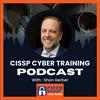314 episodes

CCT 311: Practice CISSP Questions and AI In The SOC (Domain 3)
01/1/2026 | 28 mins.
Send us a textReady to turn CISSP Domain 3.5 into practical moves you can deploy on Monday? We unpack how real SOC teams apply microsegmentation, identity-aware controls, and targeted inspection to crush lateral movement without dragging performance. Along the way, we demystify AI’s role: where detection engineering benefits from crisp use cases, how Tier 1 triage speeds up, and why models still need human oversight and rigorous validation to stay trustworthy.We also step through common network design traps that drain budgets and weaken defenses. VLAN sprawl looks tidy on paper but collapses under hybrid cloud dynamics. Central chokepoints promise control yet introduce latency and single failure domains. The smarter path is selective inline inspection where risk is highest, strong encryption everywhere else, and host-based enforcement that understands identity and context after decryption. If you’ve been tempted to collapse controls into one “do-everything” appliance, we lay out the hidden cost: a fragile core that turns into a single point of failure when you need it most.To ground the theory, we walk through scenario-style questions that mirror real decisions security leaders face: stopping east-west movement, balancing HA with inspection, drawing zero trust boundaries that don’t assume implicit trust, and enforcing policy on encrypted traffic. You’ll leave with patterns you can adapt immediately: start small, define use cases, validate outputs like code, and iterate with tight feedback loops. Whether you run a SOC, partner with an MSP, or are targeting a first-time CISSP pass, this conversation gives you a clear map from concept to control. If this helped, follow the show, share it with a teammate, and leave a quick review so others can find it too.Gain exclusive access to 360 FREE CISSP Practice Questions at FreeCISSPQuestions.com and have them delivered directly to your inbox! Don’t miss this valuable opportunity to strengthen your CISSP exam preparation and boost your chances of certification success. Join now and start your journey toward CISSP mastery today!

CCT 310: Wi-Fi Hopping And Database Defense - CISSP Training
29/12/2025 | 43 mins.
Send us a textA neighboring Wi‑Fi, a handful of stolen credentials, and a quiet leap into a high‑value network—the kind of pivot that sounds cinematic until you realize how practical it is. We unpack that playbook and turn it into concrete defenses you can deploy across your environment, from client endpoints and browsers to databases, servers, and industrial control systems.We start at the edge, where phishing, drive‑by downloads, and man‑in‑the‑middle still win far too often. You’ll get a clear blueprint for upgrading endpoint security with EDR, strict patching, and browser hardening, plus when to retire or sandbox legacy applets and how to stop sensitive data bleeding from local caches. From there we map the landscape of modern data platforms: the internal, conceptual, and external layers of databases; the resilience of distributed DBs; the interoperability and pitfalls of ODBC; and the security tradeoffs between NoSQL flexibility and relational ACID guarantees. Expect practical guardrails like TLS on every link, parameterized queries for SQLi defense, and role‑based access with tight segregation of duties.Finally, we focus on servers and ICS, where downtime costs real money and, in OT, can impact safety. Learn how to prioritize hardening and patching without breaking legacy apps, isolate critical services to reduce blast radius, centralize logging to a SIEM, and apply the Purdue model to segment OT from IT. We share tested moves for OT environments—firewalls and DMZs, constrained remote access, realistic backup and recovery plans—and explain how to integrate safety and cybersecurity so alarms, procedures, and people work as one.If you find this valuable, subscribe, share it with a teammate who owns Wi‑Fi or databases, and leave a quick review telling us the first control you’ll implement this week. Your feedback helps more practitioners discover tools that actually reduce risk.Gain exclusive access to 360 FREE CISSP Practice Questions at FreeCISSPQuestions.com and have them delivered directly to your inbox! Don’t miss this valuable opportunity to strengthen your CISSP exam preparation and boost your chances of certification success. Join now and start your journey toward CISSP mastery today!

CCT 309: Practice CISSP Questions and React-To-Shell (Domain 7.6)
25/12/2025 | 27 mins.
Send us a textOne unauthenticated request should not be all it takes to compromise your app—but with React-To-Shell, that’s the reality many teams are facing. We unpack what this vulnerability hits across React server components and Next.js app router setups, why default configs can be enough to fall, and how active threat actors are already abusing it. From construction to entertainment to cloud-native platforms, the exposure is broad, the proofs are reliable and the window for safe procrastination has closed.We share a clear action plan: upgrade affected versions now, rotate secrets that touch your React servers, and turn on relevant WAF protections from providers like Cloudflare and Microsoft. Then we widen the lens to the bigger lesson: security testing that looks mature on paper can still miss API edges and misconfigurations for months. You’ll hear why credentialed vulnerability scans with passive monitoring are the lowest-impact way to surface issues in production, how “medium” findings can chain into critical compromise, and when external assessors deliver the most value for resilience rather than routine compliance.To make testing count without breaking customer-facing services, we walk through purple teaming—pairing red team attacks with blue team collaboration—to validate both technical controls and security awareness. We cover scoping rules that prevent disruption, scenarios that mirror current tradecraft, and practical CISSP takeaways for domain coverage on assessments, software security and third-party risk. If your web stack touches React, or your program relies on scans and annual pen tests alone, this is your checklist and your nudge to act.If this helped you prioritize what to fix first, subscribe, share with a teammate and leave a quick review—it helps more security folks find us and harden faster.Gain exclusive access to 360 FREE CISSP Practice Questions at FreeCISSPQuestions.com and have them delivered directly to your inbox! Don’t miss this valuable opportunity to strengthen your CISSP exam preparation and boost your chances of certification success. Join now and start your journey toward CISSP mastery today!

CCT 308: Scripted Sparrow BEC and CISSP Incident Response - Domain 7.6
22/12/2025 | 46 mins.
Send us a textA single convincing email can move real money. We break down how Scripted Sparrow and other BEC crews spoof reply chains, impersonate trusted service providers, and slip under approval thresholds to nudge finance teams into wiring funds. The threat isn’t flashy malware; it’s pressure, process gaps, and the illusion of internal approval. We talk through the red flags that matter, from sudden vendor banking changes to realistic W9 attachments and urgent payment timelines, and then lay out the safeguards that stop these scams cold.From there, we zoom out to the full incident management lifecycle and make it practical. You’ll hear how we define an incident by its impact on confidentiality, integrity, and availability, and why that clarity speeds action. We map the steps—detection, response, mitigation, reporting, recovery, remediation, and lessons learned—and explain what they look like in a real company: one-click phishing reporting for employees, prepared legal statements for regulators, isolation choices that protect revenue, and documentation habits that pay off when auditors and insurers start asking questions.We also get honest about today’s attack surface. Cloud sharing, APIs, and over-permissive identities push sensitive data to the edge, making containment harder if an attacker lands. Expect persistence: backdoors, credential reuse, and lateral movement thrive when local admin rights and flat networks remain. The antidote is a blend of stronger finance workflows, pre-briefed legal and communications teams, and regular tabletop drills that involve everyone who touches money, systems, or messaging.If you’re serious about preventing wire fraud and surviving security incidents with your business intact, this conversation gives you a focused plan you can adopt today. Subscribe, share with your finance and HR leaders, and leave a review with the one control you’ll implement first.Gain exclusive access to 360 FREE CISSP Practice Questions at FreeCISSPQuestions.com and have them delivered directly to your inbox! Don’t miss this valuable opportunity to strengthen your CISSP exam preparation and boost your chances of certification success. Join now and start your journey toward CISSP mastery today!

CCT 307: Practice CISSP Questions - Security Policies and Procedures
18/12/2025 | 20 mins.
Send us a textCheck us out at: https://www.cisspcybertraining.com/Get access to 360 FREE CISSP Questions: https://www.cisspcybertraining.com/offers/dzHKVcDB/checkoutGet access to my FREE CISSP Self-Study Essentials Videos: https://www.cisspcybertraining.com/offers/KzBKKouvHeadlines say the talent shortage is easing, yet nearly half of UK businesses still lack basic cyber skills. That disconnect sets the stage for a frank, practical tour through what actually reduces risk—no buzzwords required. We open with real takeaways from the UK’s international cyber skills initiatives and move quickly to the daily decisions that shape resilience: encryption in the cloud, least privilege by default, and how to keep role-based access control from collapsing under credential creep.We make the identity layer tangible. Single sign-on can simplify life and lower password reuse, but it also centralizes risk. We share how to counterbalance SSO with MFA, conditional access, and strong monitoring. Cloud-based IAM accelerates deployment and gives flexibility, yet brings ongoing costs and integration challenges with legacy systems; outsourcing introduces a loss of control that must be offset by airtight requirements, auditability, and vendor transparency. Phishing remains the most reliable social engineering vector, so security awareness training isn’t optional—it’s the routine that turns policy into behavior.Zero trust becomes manageable when you stop treating it like a switch and start treating it like a program. We outline a phased path: define protect surfaces, segment by sensitivity, apply continuous verification where the impact is highest, and expand deliberately. Vendor access deserves the same precision: NDAs for legal guardrails, least privilege for scope, monitoring for assurance, and scheduled reviews to remove stale permissions. Along the way, we talk mentorship, pro bono work, and competitions as concrete ways to grow talent while delivering real security outcomes.We also road-test your knowledge with a focused Domain 1.9 CISSP question set, reinforcing the core ideas with scenario-based reasoning. If you’re preparing for the CISSP or leading a security program, you’ll walk away with a clear playbook: encrypt by default, minimize access, verify continuously, and measure what matters. If this resonates, subscribe, share with a teammate, and leave a review so others can find the show.Gain exclusive access to 360 FREE CISSP Practice Questions at FreeCISSPQuestions.com and have them delivered directly to your inbox! Don’t miss this valuable opportunity to strengthen your CISSP exam preparation and boost your chances of certification success. Join now and start your journey toward CISSP mastery today!
More Education podcasts
Trending Education podcasts
About CISSP Cyber Training Podcast - CISSP Training Program
Listen to CISSP Cyber Training Podcast - CISSP Training Program, Law of Attraction Changed My Life and many other podcasts from around the world with the radio.net app

Get the free radio.net app
- Stations and podcasts to bookmark
- Stream via Wi-Fi or Bluetooth
- Supports Carplay & Android Auto
- Many other app features
Get the free radio.net app
- Stations and podcasts to bookmark
- Stream via Wi-Fi or Bluetooth
- Supports Carplay & Android Auto
- Many other app features


CISSP Cyber Training Podcast - CISSP Training Program
download the app,
start listening.


































